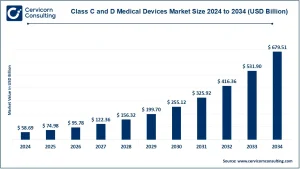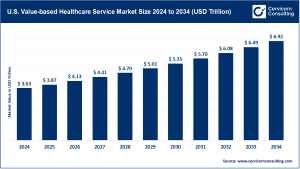Insulin Delivery Devices Market Overview
The global insulin delivery devices market was valued at approximately USD 32.61 billion in 2024 and is expected to reach around USD 55.72 billion by 2034, growing at a CAGR of 5.50% during the forecast period 2025–2034. Market expansion is primarily driven by rising diabetes prevalence, ageing populations, increased adoption of home-based care models, and rapid innovations in connected and automated insulin delivery systems.
Key Segment Insights:
-
Product: Insulin pumps lead the market in value, while insulin pens dominate in volume due to portability and patient acceptance.
-
Application: Type II diabetes represents the largest end-user base.
-
End-User Channel: Home care remains the most significant channel.
-
Distribution: Retail pharmacies are the primary distribution route.
Key Market Trends
-
Expansion of Closed-Loop (“Artificial Pancreas”) Systems
Hybrid and fully closed-loop systems that automatically adjust insulin based on continuous glucose monitoring (CGM) data are gaining regulatory approvals and market traction. These devices improve glycemic control and reduce the need for manual dosing interventions. -
Emergence of Wearable and Patch-Based Delivery
Discreet insulin patches and wearable devices are becoming patient-friendly alternatives to pumps and syringes. Next-generation patches integrated with glucose sensors provide near-continuous insulin delivery while improving adherence. -
Integration with Biosensors, Connectivity, and AI Analytics
Modern insulin devices are increasingly linked with CGMs, mobile apps, cloud analytics, and AI-driven dosing algorithms. This integration enables remote monitoring, predictive dose adjustments, and personalized therapy, supporting telemedicine and home-care workflows. -
Advances in Materials and Minimally Invasive Technologies
Innovations in biocompatible coatings, bioresorbable materials, and implantable designs enhance device safety, reduce infection risks, and improve long-term usability. -
Growing Focus on Smart and Reusable Pens
Smart reusable insulin pens with dose memory and Bluetooth connectivity are gaining popularity among ambulatory patients, offering portability and adherence tracking through connected apps.
Market Drivers
-
Increasing Diabetes Prevalence
A rising population with Type I and Type II diabetes fuels demand for user-friendly and accurate insulin administration devices. -
Shift Toward Home and Outpatient Care
Decentralized care models, including home-based care, telehealth, and remote patient management, are increasing adoption of connected insulin devices that enable clinician oversight remotely. -
Technological Innovations and Connected Care
Integration of CGMs, AI algorithms, wearable patches, and smartphone apps delivers higher-value devices such as smart pens and closed-loop pumps, improving outcomes and justifying premium pricing. -
Regional Healthcare Investments and Reimbursement Policies
North America leads the market due to advanced healthcare infrastructure, favorable reimbursement policies, and early adoption of connected systems, boosting commercialization. -
Affordability Initiatives in Emerging Markets
Government programs and local manufacturing investments in Asia-Pacific and LAMEA expand access by subsidizing pumps and producing low-cost syringes/pens.
Impact of Trends and Drivers
-
Products: Closed-loop systems and wearable patches strengthen insulin pump and patch segments, while smart pens dominate in convenience and volume.
-
Applications: Type II diabetes drives demand for pens and simpler devices, while closed-loop systems mainly benefit Type I and insulin-dependent Type II patients.
-
Regions: North America remains the revenue leader, whereas Asia-Pacific is the fastest-growing region, driven by increased access, local production, and government support. LAMEA shows gradual uptake in urban/private healthcare settings.
-
End Users & Channels: Home care and retail pharmacy channels capture the majority of volumes, with self-administration and connected device monitoring increasing adoption.
Challenges and Opportunities
Challenges:
-
Complex regulatory approval processes for automated and implantable devices can delay market entry.
-
High device costs and inconsistent reimbursement limit access to advanced pumps and closed-loop systems.
-
Technical complexity and training requirements may hinder adoption in lower-resource areas.
Opportunities:
-
AI-driven personalized therapies reduce hypoglycemia and hospitalization, offering value for payors and health systems.
-
Affordability programs and local manufacturing in APAC and LAMEA unlock underserved markets.
-
Telemedicine integration creates recurring revenue opportunities through connected devices and data platforms.
Future Outlook
The insulin delivery devices market is projected to grow from USD 32.61 billion in 2024 to USD 55.72 billion by 2034, at a CAGR of ~5.50%. Continued innovation in closed-loop automation, wearable patches, CGM integration, and AI analytics will drive long-term growth. North America will remain the leading revenue market, while Asia-Pacific offers the highest growth potential as access, affordability, and local production expand.

